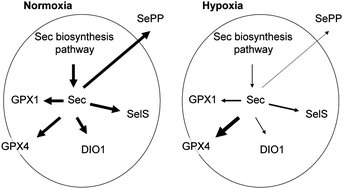Hypoxia reduces and redirects selenoprotein biosynthesis†
Abstract
Selenium deficiency constitutes a risk factor for the incidence and negative course of severe diseases including sepsis, stroke, autoimmune diseases or cancer. In this study, hypoxia is identified as a powerful stimulus to redirect selenoprotein biosynthesis causing reduced selenoprotein P expression and diminished selenium export from hepatocytes in favour of increased biosynthesis of the essential protective intracellular phospholipid hydroperoxide glutathione peroxidase GPX4. Specifically, hypoxia decreases transcript concentrations of central factors controlling selenium and selenocysteine metabolism including selenophosphate synthetase-2, phosphoseryl-tRNASerSec kinase and selenocysteine lyase, which are all proven to be rate-limiting enzymes in selenoprotein biosynthesis. These effects are paralleled by a general decline of selenoprotein expression; however, not all selenoproteins are affected to the same extent by hypoxia, and GPX4 constitutes an exception as its expression becomes slightly increased. Supplemental selenium is able to overcome the hypoxia-dependent down regulation of selenoprotein expression in our cell culture model system, supporting the concept of using selenium as an adjuvant treatment option in severe diseases. Although it remains to be tested whether these effects constitute a hepatocyte-specific response, the selenium-dependent decline of selenoprotein P biosynthesis under hypoxic conditions may explain the progressive selenium deficit developing in severe diseases.


 Please wait while we load your content...
Please wait while we load your content...